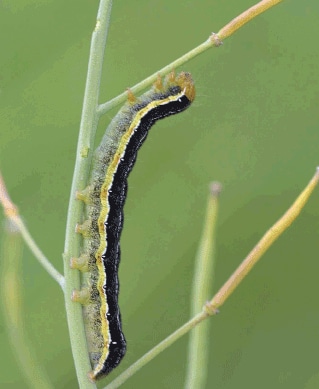Bertha Armyworm Near Economic Thresholds
Hot, dry weather has been favorable for bertha armyworm numbers. Some growers in Manitoba, eastern Saskatchewan and the Peace River region have already sprayed as of early August 2011. All growers should scout canola fields immediately.
At a canola price of $12 per bushel and application costs of $12 per acre, the economic threshold is 17 bertha armyworms per square metre. (See the thresholds chart below.) At that number, bertha armyworms can reduce canola yields by roughly one bushel per acre. Counts of 200 per square metre can reduce yields by 50%.
Bertha armyworm larvae tend to eat leaves first, but will feed on stems and pods if plants drop their leaves before the larvae are mature.
Mature larvae are green, brown or black with a light brown head and an orange stripe along each side. They are 1” to 1.5” long. (See the photo.) The most damaging larval stages are when worms are 0.5” long and larger. Small larvae feed on the underside of leaves, but usually cause little economic damage even when population levels are high.

Mature bertha armyworm. Source: Roy Ellis
Scouting tips
Go out in early morning or late evening when larvae are mostly active. Mark out an area a quarter-metre square (50 cm by 50 cm) and beat the plants growing within that area to dislodge the larvae. Count the larvae that have fallen to the ground and multiply by 4 to get the number per metre square.
Larvae will hide under leaf litter and in cracks, so check closely.
Sample at least three locations a minimum of 50 metres apart. Do not sample headlands and areas within the crop that are not representative of the field. Use the average number of larvae at the sites surveyed to determine if the economic threshold has been exceeded.
Scout each field. Adjacent fields may have very different larval densities, depending on how attractive the crop was when the moths were laying their eggs. Adjacent fields may also have different-sized larvae, depending on when the eggs were laid.
For best results, apply an insecticide as soon as economic thresholds are reached. A single well-timed application of any registered insecticide is usually effective. Check provincial crop protection guides for registered insecticides.
Because bertha armyworm feeding can continue through August, check the pre-harvest interval for an insecticide before spraying. Some insecticides have a 30-day pre-harvest interval, which means they cannot be applied within 30 days of swathing or straight combining. Some products have a 7-day pre-harvest interval, making them a good option for bertha armyworm control over the next couple weeks. (See the pre-harvest interval table below.)
Apply insecticides early in the morning or late evening when the larvae are actively feeding. Do not apply during warm afternoons.
Be bee safe
Early morning or late evening applications will also minimize damage to honey bees. Honey bees forage for nectar and pollen when the sun is up and during warmer parts of the day. If insecticide is applied when bees are not in the field, bee losses can be significantly reduced.
Where hives are nearby, growers and applicators are encouraged to contact the beekeeper about an insecticide application, the type of insecticide being used, and the steps that are already being taken to reduce bee kills. The beekeeper can then decide if additional measures should be taken to minimize bee damage. The beekeeper may cover or temporarily move the hives if this is possible.